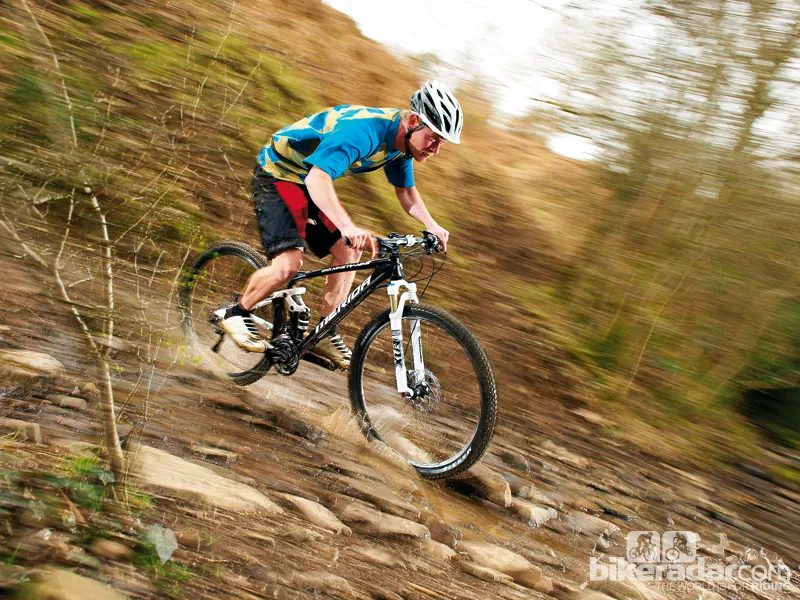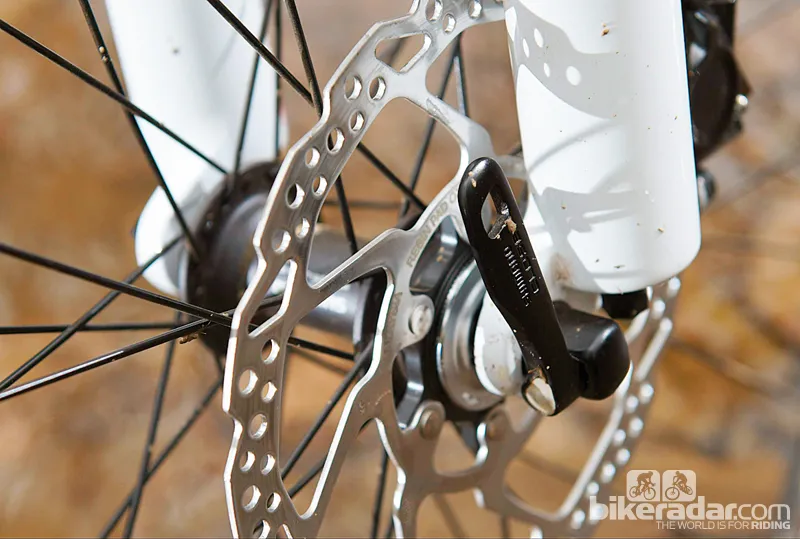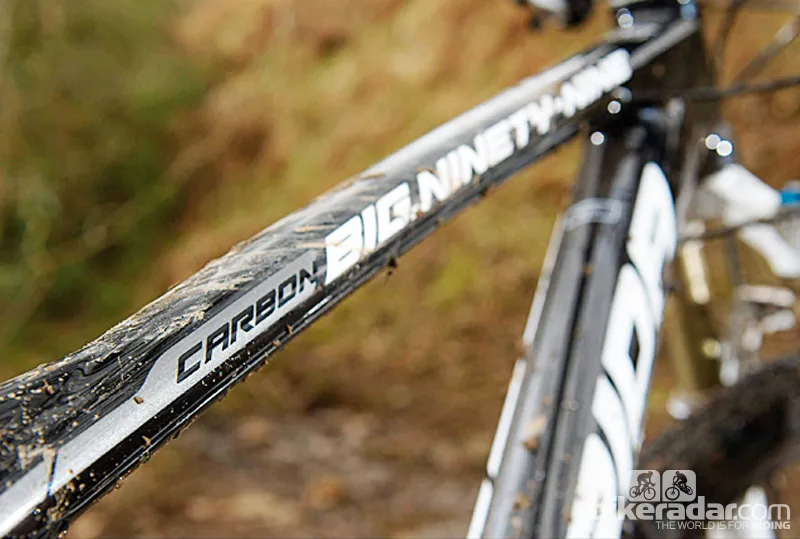Can Merida’s Big Ninety-Nine Pro XT Edition 29er marathon machine boost the ultra-light, race-winning legacy of the 26in-wheeled Ninety-Nine, or does its Euro-style suspension spec simply lock it out of contention?
Ride & handling: Stiff but not speedy
Unfortunately, the wheel and overall weight is noticeable straight away under acceleration. Lack of initial snap isn’t unusual for a 29er, but even once you’ve got the Merida rolling there’s a definite ‘loaded truck’ process of working slowly up through each gear rather than just giving it some and jumping up several cogs at a time.
As it’s primarily a weight issue it’s most obvious on climbs; on the flat that extra momentum can actually help the bike punch through short, sticky mud or rutted sections.
While the steering is twitchy, the steep seat angle and short stem shunt your weight forward. We soon learned that if we just charged straight at moorland climbs through the heather, rather than trying to steer up twisty singletrack, the results were a lot better.
The rear shock lockout on the bar helps when you have to grunt it up something steep and smooth, and the frame is extremely stiff – there’s no trace of twist or flex even if you’re really trying to rip it apart at low revs.
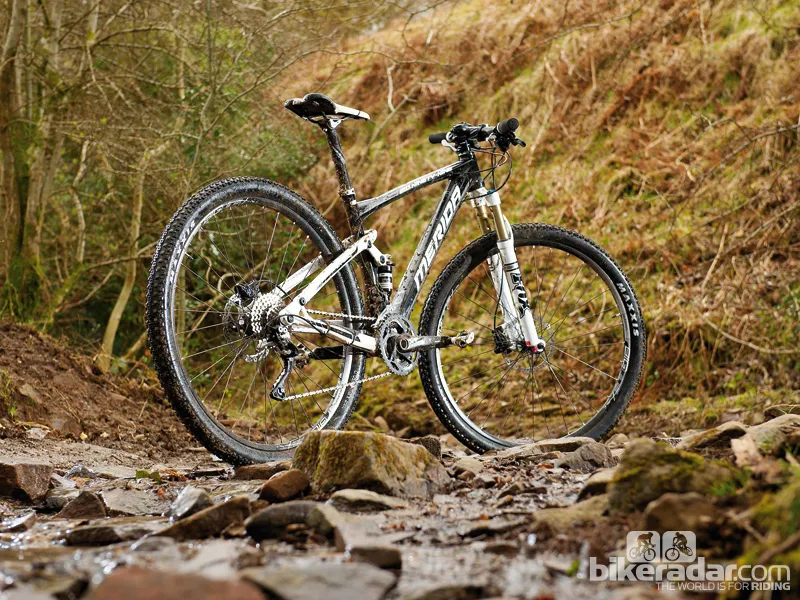
Merida Big Ninety-Nine Pro XT Edition
Unfortunately, we struggled to find a happy medium with the shock. Our initial riverside singletrack ride saw us repeatedly dropping shock pressure to try and get the rear shock to feel supple.
Eventually, we dropped it enough to flow – rather than skip – over ruts and roots for traction, but at that point even the smallest hop or drop would blow straight through to a thumping bottom-out. Low pressures also left the rear end lurching under pedalling, so out came the shock pump and back to standard sag we went.
Suspension that gives very little initial movement before giving up a sudden rush through travel over bigger hits is a very European trait, and we know some racers who seem to genuinely like it.
For us, this literally all-or-nothing approach made tuning a balanced ride and consistent rebound response out of the Big Ninety-Nine extremely hard. We reckon most racers would be better served by the impressively light but smooth Big Nine Carbon XT-M hardtail for the same price.
While the frame is stiff, the short stem and steep angles undermine the stability advantages of the bigger wheels. Fork tip flex and the initially firm shock feel also restrict line-holding traction, and we repeatedly ended up travelling sideways or sat on our arse on corners/off cambers that bikes with similar tyres and travel don’t even blink at.
Frame & equipment: Heavy chassis and needs a plusher shock
The basic layout of the Big Ninety-Nine is exactly the same as the 26in-wheeled Ninety-Nine Pro XT, and it uses a carbon fibre front end mated to an alloy rear end. That big down tube uses an internal rib to increase stiffness and strength, plus a nano-enriched bonding resin to increase impact resistance. The extensively hydroformed rear end includes a hooped seatstay top end for tyre clearance, while a one-piece ‘A’ rocker drives the DT shock.
The rear pivots are mounted comparatively high on the seatstays, so the rear wheel actually moves in a single-pivot arc and not a fully altered, four-bar fashion. This does leave easy pad-changing space for the chainstay-mounted rear brake, and the 142x12mm rear axle makes for an impressively stiff rear end. The conventional bottom bracket will also please any traditionalists not convinced about press-fit systems.
On the subject of fit, Merida UK routinely bring small, medium and large frames in as standard, but will do their best to source extra-small or extra-large bikes from another country if that’s what you need.
As you’d expect for a bike named Pro XT, the triple chainset, mechs and shifters are from Shimano’s totally trustworthy group, though the Centerlock hubs are SLX and the M446 brakes – while they stop predictably enough – are definitely at the cheap and chunky end of things.
The Merida-branded Alex rims aren’t light either, but took a battering on test without wobbling or denting. These low tread CrossMark tyres are a great choice for fast riding in firmer conditions, but they can slide in slop if you’re too heavy handed.
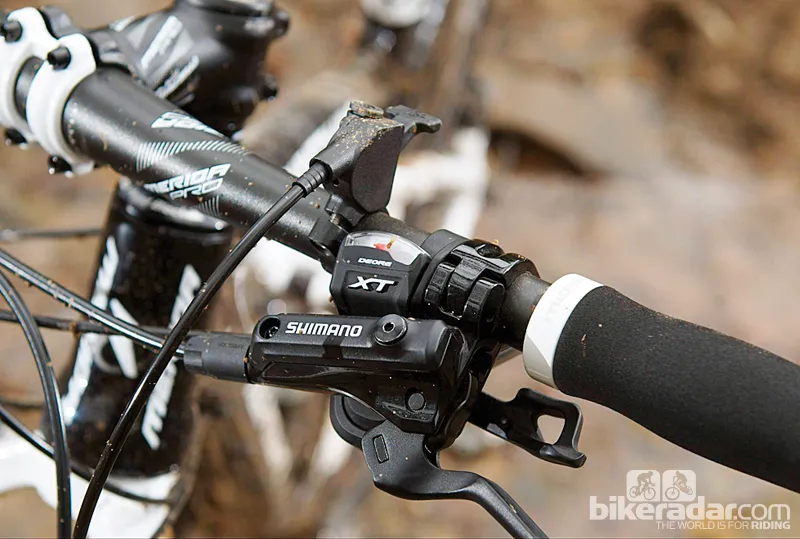
The Shimano XT transmission is trustworthy kit
More significant to the steering is the Fox fork – or at least the far end of it. Fox generally get more control and capability out of their 100mm forks than anyone else, and even this mid-range unit feels great when rattling flat out down steps or across rooty/rocky sections.
The CTD damper gives three distinctly separate sensitivity settings for climbing, trail and descending, which matches it well with the bar-controlled rear shock. Yet while the top end of the fork is tapered for stiffness, the wheel end gets an increasingly old-fashioned quick-release skewer rather than a proper 15mm screw-thru axle. The resulting twist at the tips is very obvious when you’re turning or trying to force a line against the grain of the terrain.
The narrow bar is unsurprising for a race bike but doesn’t add much helpful leverage, and the short stem emphasises the relatively steep steering angle. And while the carbon seatpost saves a few grams, overall weight is still high for an alloy – let alone carbon – short-travel bike designed for marathon racing.
Merida’s Big Ninety-Nine frame is a tough and impressively stiff chassis with steep, traditional race-style angles and a remote shock that will undoubtedly appeal to the fast and far cross-country brigade. High weight hampers its ability to turn stiffness into speed though, and the numb shock feel and twisty QR fork undermine your control.
This article was originally published in What Mountain Bike magazine, available on Apple Newsstand and Zinio.

